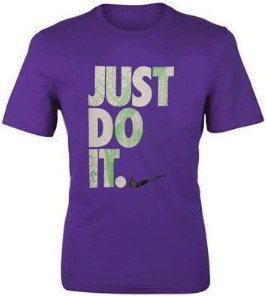I f you’re like me, you have one or more drawers full of promotional T-shirts. And you probably have them in many different colors and with many different graphics, logos and phrases. Some say things that you are afraid to wear outside the house. Some are worn and faded.
f you’re like me, you have one or more drawers full of promotional T-shirts. And you probably have them in many different colors and with many different graphics, logos and phrases. Some say things that you are afraid to wear outside the house. Some are worn and faded.
“That one needs to go,” my new wife often says to me. I just chuckle and go on wearing it. That’s what I want to talk about this week — the difference between giving away a favorite T-shirt that people cling to beyond all reason and just another T-shirt.
T-shirts can be a powerful walking billboard. A good T-shirt does double duty as it is a constant reminder to the wearer of you, the giver, and they show your message to dozens or possibly hundreds of people every day that they are worn. That’s marketing power. So what makes for a good T-shirt?
T-shirts are made special in three ways: they commemorate an event like a concert, sporting event or visit to a tourist location: the print (graphic, logo or phrase) is one you like being seen wearing: and the fabric feels good against your skin or fits particularly well.
Commemorative T-shirts are generally created for retailers by professional designers. Most of you who are reading this are neither of those. However, some family and company events do deserve commemoration. Should you find yourself involved in such an event, then apply the rules we will be discussing later and you will be happier with the end product. If you are lucky enough to be using a nationally branded logo that is considered cool to wear, then you don’t need much more than that to get your T-shirt worn often. The rest of us, who have logos that are less well known, may need to add graphics, catchy phrases or effects around or behind it in order to create desire to wear it.
Often as not, it is a creative use of colors and shapes in the print that makes a T-shirt special. If your screen-printer has a full-time professional artist, he can take a mundane logo or design idea and make it a work of art. The really good ones can make an eye-catching print with just one or two colors, which saves you a lot of money. Using a professional artist might seem expensive but most work for between $30 and $50 per hour and can complete most designs in one or two hours. This is a small percentage of the overall cost of most T-shirt orders and can make the difference between a T-shirt that is worn a hundred times and one that is tossed in the garbage.
Sometimes, a catchy, funny or provocative phrase can be enough to increase the wear of your T-shirt. Think “Just Do It!” or “Life Is Good.” Use phrases that reflect an attitude (positive is almost always better when marketing a business) that has broad appeal. If you use one that appeals to a narrow demographic, then expect a majority to ignore it when choosing what to wear.
Most of my customers are surprised to learn that there are many ways to decorate a shirt besides standard vinyl inks. There are water-based inks that are soft after one washing (The most comfortable print for hot weather). Fashion inks that are somewhere in between. Laser engraving that burns the surface of the shirt but adds no pigment. Heat press debossing/embossing where the message is pressed into or raised in the fabric. There are many more and new ones are being invented all the time. Sometimes just decorating a T-shirt in a new and different way can be enough to make users want to wear them.
Lastly, let’s talk fabrics — the most overlooked aspect of the T-shirt buying process. You have this great graphic in mind and when it comes to choosing the fabric you ask, ‘What’s the least expensive?” Well, if a generic heavy cotton costs $5 and a fashion weight ring-spun ultra soft 4 oz. cotton costs $7, then the heavy cotton is the better deal right? Wrong. The fashion weight ring-spun is incredibly soft and light and most people prefer it hands down over the base model. Therefore, the fashion weight is worn many times more often and is a far better buy dollar for dollar than the heavy cotton. That is not to say you have to increase your budget for the better fabric. You are just as well off buying fewer of a better shirt than having more just end up in the landfill.
T-shirts are an excellent promotional medium but it takes thought and knowledge to make them truly effective. Take the time to choose the right fabric, decoration method, and image then watch your walking billboards do their job.
Photo: T-shirts are great ways to advertise, but there are a few things to think about first.